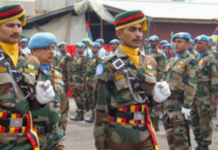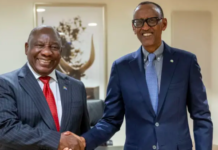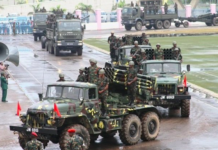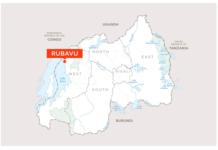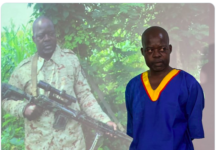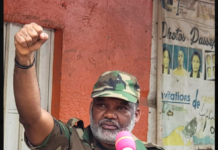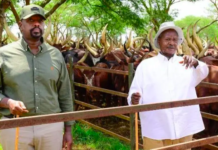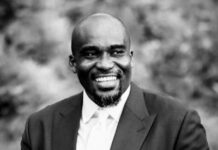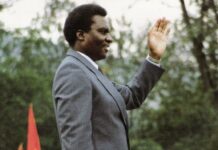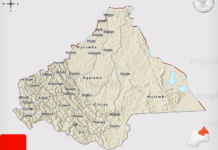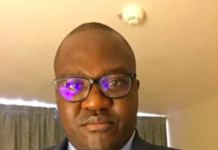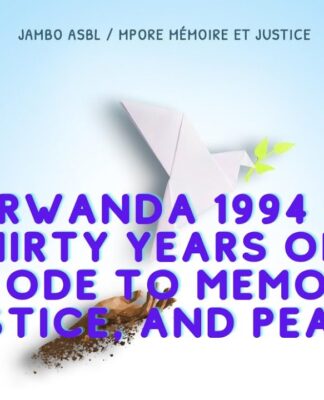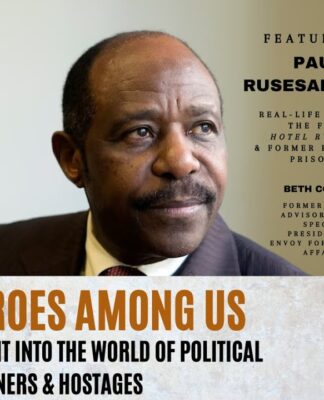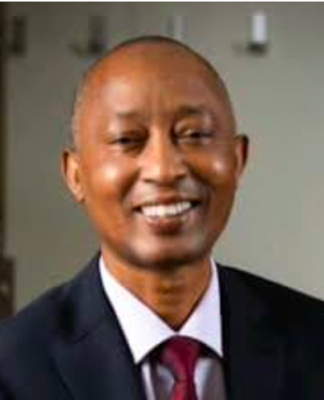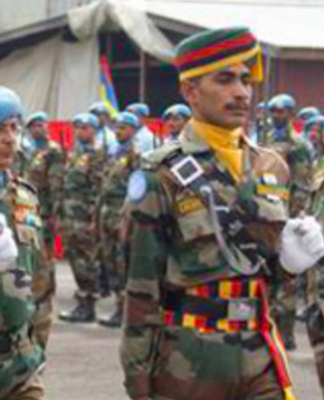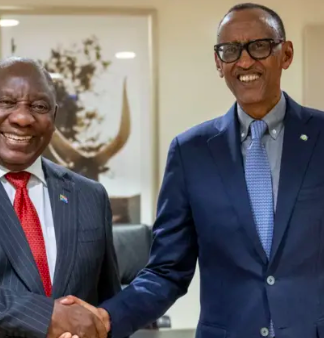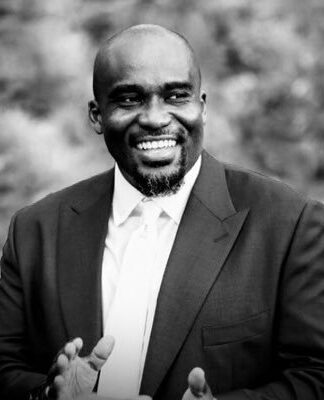By Judi Rever

“We could see the machete wounds to the head, and on their arms and bodies. They were just emerging from the horror.” — French Vice-Admiral Marin Gillier, upon finding hundreds of wounded Tutsi in the hills of Bisesero in late June, 1994.
Former soldiers who served in Paul Kagame’s army and a Tutsi survivor saved by French soldiers under Operation Turquoise reveal a shocking story that changes our understanding of the Rwandan genocide.
The cadence of Martin’s speech, which is normally swift and steady, abruptly changes when he talks about Bisesero, in southwestern Rwanda, in 1994.
“They killed my mother and father. They killed my two sisters, and my elder and younger brothers,” he told me, his voice soft and breaking. “They used bayonets, small hoes and grenades to slaughter them. I was unable to bury my family and it was pure, psychological torture when I discovered who was responsible.”
Martin, who requested anonymity for reasons of safety, is a Tutsi who grew up in undulating hills of Bisesero. As a young man he joined Paul Kagame’s Rwandan Patriotic Front (RPF), which swept to victory in July 1994 and is credited for staunching the bloodshed against Tutsis.
For 25 years, Kagame has been idealized for liberating a country that was brought to the brink of madness in 1994. Researchers worldwide have taken great pains to comprehend how so many Tutsis could be wiped out so fast in the tiny central African nation over the space of 100 days. The official story told in history books and by survivors living in Kagame’s tightly-controlled Rwanda is that the former Hutu government and its willing executioners were desperate to hold onto power and decided to exterminate Rwanda’s Tutsi minority, one machete at a time. While there is some disagreement about the number of Tutsi victims who are estimated to be between 500,000 and a million people, there is no historical dispute about the level of brutality and the speed at which Rwandan Tutsis lost their lives from April to July 1994.
Bisesero, a Tutsi stronghold where tens of thousands of victims[1] were hacked, shot or burned to death by mobs of killers, is cited as an example of the “purest” form or genocide against Tutsis in 1994.
And yet there is no doubt in Martin’s mind about the person who ultimately planned and ordered the abominable massacres of Tutsis in Bisesero. He says the mastermind was Paul Kagame himself.
In a country where Hutus and Tutsis largely resemble one another and share the same language and culture, Kagame and his military aides devised a strategy of military deception known as insider attacks.[2] In these schemes, Kagame’s Tutsi soldiers disguised themselves as Hutu militia and attacked civilians. The terror resulting from the carnage produced equal measures of fear and disgust at home and abroad, which provided the RPF with political capital to achieve its tactical, national and international goals.
Infiltrate, disguise and deceive
Martin and four other soldiers who served under Kagame say commandos from the RPF’s battalions infiltrated Hutu militia and slaughtered Tutsis in Bisesero in savage ways. They described RPF commandos seizing Tutsis in their homes or chasing them over hills into ravines, using hoes and homemade cudgels — clubs with nails and sharp pieces of metal — to strike victims in the head and heart.
The sources said hundreds of RPF commandos descended upon Bisesero and its surrounding areas of Mumubuga, Uwingabo, Mataba, Kagari, Ngoma, Muyira and throughout the greater region of Kibuye. Working with Hutu militia known as the Interahamwe, these commandos launched a spate of initial attacks in the region in mid and late May at the height of the genocide. The Interahamwe militia were the youth wing of the ruling, MRND party of President Juvenal Habyarimana, many of whose early recruits were jobless, displaced and hungry.[3] RPF commandos were also known to have infiltrated the militia of Hutu opposition parties.[4]
Tutsis in Bisesero mounted an unusual, stiff resistance during the early phase of militia attacks, fighting off killers with spears and other traditional weapons. Their bravery and strength were so remarkable that Kagame himself called attention to it in one of his speeches: “One major exception to the pattern of defenselessness and desperation stands out in the annals of the grisly period of the genocide. The resistance put up by thousands of mostly unarmed Tutsi at Bisesero in Kibuye Province in the west of Rwanda constitutes a memorial in itself to the determination of one major group of the population to not become victims.”[5]
And yet the RPF, in one of the most deceptive and well-planned operations in 1994, ultimately broke the resistance of Tutsis in Bisesero and ensured they died in the thousands by late June, just as the French army was arriving to provide humanitarian assistance to Rwanda.
Kagame tasked his most trusted senior commanders — James Kaberebe and Charles Kayonga — to organize the Bisesero operation, according to several sources who have fled Rwanda and requested anonymity for reasons of safety. Kabarebe oversaw Kagame’s security guards in the High Command battalion, and Kayonga headed the 3rd battalion stationed in Kigali where commandos transited before being deployed in the regions. The sources have described how Kabarebe and Kayonga flooded the area with increased numbers of commandos and weapons — in particular grenades and guns — and then received military reinforcement from a small group of soldiers from Habyarimana’s army in Kibuye. However a former RPF intelligence official who confirmed the RPF’s leading role in the Bisesero slaughter said the Hutu military had fled the area by late June and was not involved in killing Tutsis there. “That is pure fiction. When Tutsis were killed in Bisesero by the Interahamwe and RPF commandos, the FAR (Hutu army) was on the run.”
Martin says he knows what happened to his family and other Tutsis in Bisesero because the men who were part of the operation told him what happened, and that these men were commandos in Kagame’s battalions.
Five former members of Kagame’s military provided the names of some 40 commandos who killed Tutsis in Bisesero. The commandos were mostly ethnic Tutsis and members of several RPF battalions, including the 11th battalion, the 59th battalion, the 101th battalion and the RPF’s Charlie mobile force. A number of commandos expressed deep remorse for slaughtering Tutsis, according to three of the sources. Some were “sickened” by having killed fellow Tutsis and experienced trauma but had no choice because they feared they’d be executed if they did not obey orders, they said. The names of the commandos have been withheld for reasons of confidentiality and safety. Some commandos were killed by the RPF after the genocide but many of them are still alive and could be eliminated if their names were exposed, according to the sources.
The majority of former military sources who gave me their testimony were too afraid to speak on the record for fear of being killed. Yet one soldier who left Rwanda more than a decade ago has come out of the shadows and agreed to be identified. His name is James Munyandinda,[6] and he was one of Kagame’s close bodyguards in the High Command battalion. Munyandinda is certain that Kagame, Kaberebe and Kayonga directed RPF commandos to kill in Bisesero and throughout Rwanda. He said he heard them talking about the operations on Motorola walkie-talkie radios, in May, June and early July.
“I heard Kagame on Motorala asking Kabarebe how the activities were going in Bisesero. He said ‘do you have news?’ He also asked Kaberebe whether the killings were successful,” said Munyandinda, who accompanied Kagame everywhere as his close bodyguard.
Munyandinda said he also heard Kabarebe asking Kayonga for a situation report in Bisesero. He heard Kaberebe use the word abatabazi, which is Kinyarwanda for “interveners” — a code word for the commandos. Kaberebe also inquired about the number of people slaughtered and Kayonga responded by saying that everything was running “smoothly,” according to Munyandinda.
While the infiltration of killer mobs of Bisesero and other areas of Rwanda was put into place by Kabarebe and Kayonga, a few sources said the plan was conceived, organized and coordinated by two of Kagame’s smartest and most senior commanders: Kayumba Nyamwasa and Emmanuel Karenzi Karake. Nyamwasa was then head of the Directorate of Military Intelligence (DMI) — and Karake was the RPF’s liaison officer with UNAMIR and the OAU’s Neutral Military Observation Group known as GOMN before the genocide. Karake’s liaison with UNAMIR and GOMN gave him privileged access to the capital and the regions, which enabled him to collect intelligence, oversee infiltration of the entire country, recruit new members, conduct sabotage and organize crimes.
However, Munyandinda said he did not believe that Nyamwasa was involved in organizing or authorizing RPF commando operations to infiltrate Hutu militia. He had no evidence whatsoever, he said, that Nyamwasa had any role in the massacre of Tutsis in Bisesero.. Munyandinda insisted the operation was overseen by the RPF’s High Command, under the authority of Kagame and supervised by Kaberebe and Kayonga. “I do not have any evidence that Nyamwasa, as head of DMI, was involved with the network commandos. The killings of Tutsis in Bisesero and other areas of Rwanda were organized by the High Command, which oversaw many special operations,” he told me.
Political cadres
Sources said that civilian cadres of the RPF, who were known as abakada, worked on the ground with Hutu cadres from various opposition parties such as PL, PSD and MDR[7] to ensure infiltration of Hutu militia. These cadres facilitated Hutu identification cards and managed to falsify MRND membership cards for the commandos to use, according to the sources.
The senior RPF cadres who oversaw operations in Bisesero were from Kibuye, according to the soldiers interviewed. These Tutsi cadres brought grenades and traditional weapons into their homes and convinced other Tutsis to hide weapons at their residences in the months leading up to the genocide.
Sources said the number of commandos deployed across Rwanda was in the several thousands. These infiltrators included Tutsi members of the RPF resembling Hutus and Hutus recruited for commando training by Hutu cadres opposed to Habyarimana’s government.
Sources said Hutu opposition figures worked hand-in-hand with the RPF in this infiltration scheme because they wanted to undermine Habyarimana’s government, both on the ground and in the eyes of the international community, even if it was not clear among these sources whether the Hutu opposition parties knew the full extent of the RPF’s strategy in infiltrating the militias bent on exterminating Tutsis.
Sources said interior Tutsis — Tutsis who grew up in Rwanda unlike others who were raised as refugees in Uganda, Burundi, Congo and Tanzania — were sacrificed as part of the RPF’s greater political ambitions. “Kagame used Tutsis inside the country as a bridge to achieve power. He killed Tutsis and has put a lot of effort into convincing the world that only Hutus were responsible,” said James Munyandinda.
“The whole world is sympathetic to Kagame because he’s made it look like a majority of Hutus killed Tutsis and that he defended the victims in the Rwandan holocaust we all know happened,” another source, a senior officer said. “This is the card that Kagame is still playing today. His strategy all along was to get power and become the leader of the country.”
Getting the Killers Ready
The commando training began in February 1992 and ended in August 1993, according to sources. The RPF secretly trained the commandos in waves, initially at a hidden location called Kavu, in northern Rwanda, before shifting into the nearby Karama valley, which was surrounded by a banana plantation.
“They were shooting, they were running, jumping, training….one group after another. Sometimes 80 men were trained, sometimes 200 or even 300 at a time.
By the end of 1993, the commandos had become a very big group,” a senior officer explained. Soldiers said several thousand young men underwent commando training and were deployed in Kigali and across Rwanda by January 1994, ready to move after the assassination of Habyarimana on April 6, 1994.
Five sources with detailed knowledge of the operation in Bisesero said that a captain nicknamed Kiyago was the ground commander for Kagame’s commandos.
“Kiyago led the commandos in Bisesero and in several other operations,” Munyandinda said, adding: “James Kaberebe received reports directly from Kiyago in the morning and evening, on the Motorola, of activities in the field.”
Captain Kiyago was cited as a perpetrator of grave crimes in a UN confidential investigation. He, among others, is known to have infiltrated Hutu militia on behalf of the RPF, and having participated directly in killing Tutsis.[8] In 2008, he was indicted by a Spanish judge on charges of terrorism for separate offenses committed prior to the genocide.[9] Despite the Spanish indictment and the UN investigation at the International Criminal Tribunal for Rwanda, Kiyago joined the joint UN-African Union peacekeeping force in Darfur as a director of transport between 2009 and 2011.
Kiyago’s former colleagues describe him as both sadistic and dangerous. “He is someone who would do anything to get ahead and was often used by Kagame,” said an officer who knew Kiyago from their early days fighting together in Yoweri Museveni’s rebel National Resistance Army.
Kiyago, whose actual name is Godfrey Ntukayajemo, is an ethnic Hutu who grew up in Kisoro, in the Rukiga district of Western Uganda, where Rwanda’s longtime intelligence enforcer Jacques Nziza is known to have hailed from. Despite being Hutu, Kiyago became a soldier in Museveni’s rebel army in the 1980s, along with many Rwandan Tutsis living in exile in Uganda. Because of his appearance and accent — “he talked like his Hutu cousins in Ruhengeri,” in northwestern Rwanda, said a senior officer — he was chosen to intfiltrate the interahamwe. “Kiyago was a commander of the RPF’s major missions. He was always on the floor.“
He is alleged to have murdered Felicien Gatabazi, a Hutu opposition politician, in February 1994, an act that spurred greater violence in the run-up to the genocide and provided a taste of the nightmare to come. And Kiyago helped slaughter Lando Ndasingwa and his Canadian wife Hélène Pinsky and their two children after the genocide was unleashed, sources have said. Lando was a Tutsi minister in Habyarimana’s government and was the brother of Louise Mushikiwabo, Kagame’s long serving foreign minister who in 2018 became the secretary general of the Francophonie. Kiyago was convicted for raping and killing a woman and her daughter when their family insisted on reclaiming their house he had seized after the genocide, several sources say. Kiyago spent time in prison but got an early release and became a UN peacekeeper in Sudan. He was initially tapped, in 2011, to assassinate Rwandan dissidents Kayumba Nyamwasa and Patrick Karegeya, according to recordings obtained in 2014 by the Canadian newspaper, the Globe and Mail, but was ultimately not sent to carry out the job, likely because of the international arrest warrant issued against him by Spain.
Former colleagues who know Kiyago well have pointed to his current Facebook page, under the name Kiyago Godfery. https://www.facebook.com/kiyago.godfery
The account features pictures of him jumping in the air with foreign nationals in Rwanda’s Akagera Park as though he were a tour guide, along with serene photos of his mother, his children, a few women he’s had relationships with, and one of Kagame with his son and daughter in battle fatigues. The account includes sober pictures of him when he was younger, to more recent, relaxed portraits in his middle age. He makes references to his time in Darfur while working as a driver for the United Nations, and posts a doctored, bloody photo of a masked man who has torn his heart out to give to a girl. A post from 2018 says: “only in the darkness can you see the stars,” a variation of a quote from Martin Luther King, Jr.
Kiyago also appears to maintain a dormant Twitter account, https://twitter.com/Godfreykiyago , in which he publicly thanks Kagame for what he’s done for him. The tweets date from 2011.
France: The Fall Guy
One of the most stinging allegations to emerge from the ashes of the Rwandan genocide has been leveled at France for the role its armed forces played in late June and July 1994 in the southwestern prefectures of Kibuye, Gikongoro and Cyangugu, under the UN-mandated humanitarian intervention, Operation Turquoise.
Rwanda says the French army failed to protect Tutsis in Bisesero and instead protected the perpetrators and was complicit in the genocide. France, the only country that intervened to save Rwandan lives in 1994, has called the accusations “monstrous.” Tutsi soldiers and survivors who’ve shared their stories with me say the charges against the French are a thinly-veiled attempt to distract from the RPF’s leading role in the massacre of Tutsis and for years were aimed at pressuring France to drop a judicial investigation into the RPF’s role in assassinating Habyarimana and unleashing the genocide. In December 2018, French judge Jean Marc Herbaut dismissed the case against RPF commanders, citing a lack of sufficient evidence. Lawyers for the civil parties in the case, who include families of the French crew killed in the plane attack, have appealed the ruling.
Vice Admiral Marin Gillier was part of a special forces team from France tasked with finding survivors and setting up a safe haven for them under Operation Turquoise. On June 24, during the first few days of their arrival in Rwanda, they conducted reconnaissance at a Hutu displacement camp in Kirambo and in villages throughout Kibuye, near Bisesero and discovered a traumatized population.
“The people we came upon were traumatized by the ravages of hunger, fear, disease and cruelty. We witnessed suffering everywhere,” he said.
On June 27, during a trip to Gishyita, northwest of Bisesero, villagers told French soldiers that the RPF had completely infiltrated the hills throughout Kibuye and “was trying to divide the country in two.” But Gillier, a captain at the time, did not know what to make of these stories. He nevertheless documented the reports of alleged RPF infiltration and tabled an official account of his observations to a French parliamentary mission in June 1998.[10]
“All day long Rwandans were giving us their accounts. Some of their stories were surely true and others were false. It was hard to know who was trying to manipulate us and why, and what the truth actually was.”
French forces began moving further east, five kilometres to the hills of Bisesero, and heard what they thought was artillery fire[11] coming from RPF forces. Captain Gillier informed his ground commander, Colonel Jacques Rosier. The mandate of Operation Turquoise, issued by the UN Security Council, clearly stipulated that French soldiers could not militarily engage with troops on the ground. French forces were there to protect civilians — with military force if necessary — but were forbidden to fight the RPF or support Habyarimana’s army. In any case, it was clear at that time that his team “did not have the military force or tactical support to intervene effectively.” Gillier’s team had no choice but to wait for attack helicopters equipped with cannons in order to move in and save lives in the middle of a conflict zone. He insists that there was never any hesitation[12]by French forces or the overall commander of Operation Turquoise, General Jean Claude Lafourcade, to save Tutsis in Bisesero, or elsewhere in Rwanda. As soon as the helicopters and other reinforcements arrived, they moved in immediately.
He will never forget the unmitigated suffering he witnessed when he penetrated the hills of Bisesero on June 30, 1994.
“It destroyed me,” said Gillier, who saw hundreds of corpses on the ground, some of them burned from grenade attacks, and many decomposing and bloated which indicated they had been killed days earlier.
And he saw survivors who “were just emerging from the horror. They were lying prostrate. They were depleted and cold.”
“I saw a baby trying to drink from the breast of his mother, and the mother had been beheaded,” he told me.
“A little girl came up to me. She was about as tall as my waist, and she stood there. Her skull was missing bone. It was completely exposed. I could see her brain as she spoke to me.”
The French soldiers took care of the wounded. “We hurried to bring them together, to protect them, to cover them up, to feed and reassure them, to give them medical care.”[13] An estimated 800 Tutsis were saved by the French army in the hills around Bisesero in 1994. “This was the most important mission of my life,” said Gillier, who also served in Afghanistan, Somalia and the Balkans.
Despite rescuing and providing aid to thousands of people in villages throughout southwestern Rwanda, the French army and former officials who served under the late French president Francois Mitterand have come under fire by a cabal of French journalists, researchers, activists, and lobbyists.[14] A number of these critics have built their careers on peddling the official genocide narrative that Hutus were the sole perpetrators of violence in 1994 and Kagame stopped the violence.
Pierre Péan, the first Western journalist to chronicle the crimes and propaganda of the RPF, demonstrated how Tutsis saved by the French army initially reacted with joy and gratitude in July 1994 but in later years accused French soldiers of protecting Hutu perpetrators and standing idly by as Tutsis were bludgeoned to death. Péan also exposed the contradictions and discrepancy in French journalist Patrick Saint-Exupéry’s emotionally-charged account of events,[15] and in 2015, Péan told the French judicial inquiry that the RPF had infiltrated Kibuye ahead of the Bisesero massacres. He said the RPF had established a logistical base on the shores of Lake Kivu, under the cover a health clinic, and transported weapons from the RPF’s base in Kigali, the CND, to Kibuye before French forces arrived in Bisesero.
James Munyandinda said despite Kigali’s propaganda, Rwandans are grateful to French soldiers who served under Operation Turquoise. “Kagame has tried to demonize the French army and claim that its soldiers failed to save Tutsis in Bisesero. But the French army saved thousands of people from the killers…the Hutu militia and Kagame’s network commandos. Rwandans know the French army are heroes.”
Tutsi survivors
Tutsi civilians who were victims of RPF violence or saved by Hutu neighbors, priests or Habyarimana’s military during the genocide have been unable to tell their stories because they are afraid of being killed in Rwanda or hunted down abroad by Kagame’s agents, according to many sources. Survivors have instead chosen to stay silent or agreed to lie in order to protect their families and in many cases benefit from privileges such as jobs, visas and educational opportunities.
One woman I met was deathly frightened of revealing what happened in her village outside Bisesero during and after the genocide. She agreed to share her story but insisted that if she were to identify the individuals who saved her and where she hid, the RPF would be able to figure out her identity and target her and her family. The woman recounted how a Hutu priest in her village — a person she considered a saint — sheltered her and other Tutsis as mobs of Hutu bandits went on a rampage. “We didn’t know where these bandits came from…they fell like locusts and mixed with local Hutus,” she said. She and other Tutsis were later protected and fed by members of Habyrarimana’s gendarmerie. “No one was raped or threatened by Hutu gendarmes or military troops or government leaders where I was,” she explained. Weeks later the gendarmerie brought her back to her village, where in late June she was rescued by French forces. “French soldiers never abandoned Tutsis. They rescued me, and many others. Wherever they were told a Tutsi was hiding, they went to find them. They took every indication of our whereabouts seriously.” The woman also said she saw French troops disarm and arrest Hutu thugs and militia wherever they could.
At the end of July, 1994 French military handed her and other Tutsis over to a French NGO whose staff then transferred them to a zone controlled by the RPF, at which point the unimaginable happened. The females were separated from males and brought to a house where they raped by RPF officers. “I heard girls and women screaming at night…if someone resisted they would be killed the next day.” The woman fled to the forest, escaped Rwanda through Burundi and now lives abroad.
A Tutsi named Léonard, now living in exile, lost most of his relatives in Bisesero. “After RPF seized that zone they continued killing survivors. And after the war, RPF people were very arrogant. They went into bars and talked about what the they did, about how many Tutsis were killed there.”
Many Tutsis know the RPF exterminated their families but are locked in silence.
“Interior Tutsis are desperate. Many of us are finished by this regime. We either have to cooperate or we die.”
[1] There is a vast discrepancy in estimates of Tutsis killed in Bisesero in 1994. The RPF-directed NGO, African Rights, headed by Rakiya Omaar and Alex de Waal, reported that 50,000 Tutsis were slaughtered in Bisesero in 1994. Human Rights Watch, in its seminal report Leave None to Tell the Story, wrote that a list of people killed in Bisesero totaled 5,100 names. Professor Philip Verwimp estimated there could have been no fewer than approximately 14,000 deaths. Verwimp, Philip, “Death and survival during the 1994 genocide in Rwanda” in Population Studies, Vol. 58, №2, 2004, pp. 233–245.
[2] Insider attacks have long been a war strategy among insurgents, notably in Sierra Leone by the rebel Revolutionary United Front, whose members were often disguised as government soldiers, (see https://fas.org/irp/agency/army/casebookv2.pdf ) and in Afghanistan https://mwi.usma.edu/wp-content/uploads/2017/04/Dress-Like-Allies-Kill-Like-Enemies.pdf
[3] Human Rights Watch, Leave None to Tell the Story. 1999
[4] Judi Rever, In Praise of Blood, The Crimes of the Rwandan Patriotic Front(Toronto, Random House Canada, 2018), page 60
[5] Juan Mendez, “Accountability for Past Abuses,” Human Rights Quarterly, 19, no. 2, 1997, 255–282, citation p. 278
[6] Munyandinda, who joined the RPF in Uganda in 1991 as a 15-year-old child soldier, was a witness for the French inquiry into the assassination of Habyarimana. In 2017, Munyandinda told Judge Jean-Marc Herbaut that prior to the genocide, he had been put in charge of guarding the missiles used to kill Habyarimana at the RPF’s headquarters in Mulindi.
[7] PL- Liberal Party; PSD- Social Democratic Party ; MDR — Republican Democratic Movement
[8] Judi Rever, In Praise of Blood, pages 67–68 . The General Report on the Special Investigations Concerning the Crimes Committed by the Rwandan Patriotic Army (RPA) during 1994. Report was submitted October 1, 2003, to Hassan Bubacar Jallow, ICTR Prosecutor,and Melanie Werret, Chief of Prosecutions.
[9] Spanish indictment issued on February 6, 2008, by High Court Judge Fernando Andreu Merelles charging 41 current or former high-ranking Rwandan military officials with serious crimes, including genocide, crimes against humanity, war crimes and terrorism, committed over a period of 12 years, from 1990 to 2002, against the civilian population and primarily against members of the Hutu ethnic group.
[10] Mission d’information sur le Rwanda et le rapport “Turquoise: intervention à Bisesero” par Marin Gillier, Capitaine de frigate, le 30 juin 1998
[11] After seeing victims whose bodies were burned, Officier Gillier later deduced that the sound he believed had been artillery fire was actually from grenades exploding.
[12] Gillier is highly critical of the actions of French Lt. Colonel Jean-Rémy Duval, whose detachment was deployed further north in Kibuye, but not in Bisesero. Duval said he discovered Tutsis were being attacked in his zone and promised to protect them, but Gillier said Duval did not inform his colleagues at the time. If what Duval said is true — and he did not take measures to alert others and take action — then what he did was criminal, Gillier said.
[13] Gillier said after witnessing events in Bisesero, he realized that Hutus were massacring Tutsis, but he did not see first hand the atrocities being committed.
[14] In 2005, a group of genocide survivors, along with the organizations Survie and FIDH (International Federation of Human Rights), accused the French military of abandoning Tutsis in Bisesero. A judicial inquiry into the events formally closed in October 2018, and is expected to be dismissed for lack of evidence.
[15] Pierre Péan. Noires fureurs et blancs menteurs, Éditions Fayard/Mille et une nuits, 2005
This article was first published in French in the magazine Marianne on December 21, 2019. https://www.marianne.net/monde/rwanda-revelations-sur-les-massacres-de-bisesero


